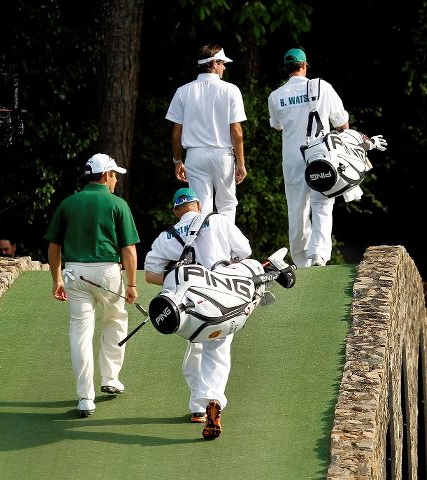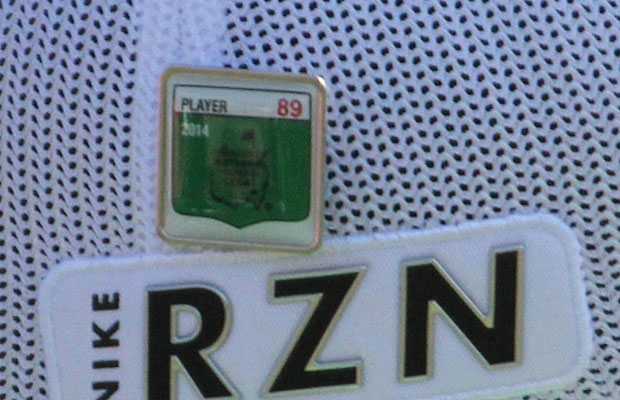Opinion & Analysis
What’s so special about the Masters?

A non-golfer and non-sports fan (apparently those exist) asked me today, what’s so special about the Masters?
I giddily replied, “Magnolia Lane, Amen Corner, Rae’s Creek, Sarazen Bridge, Blooming Azaleas, the anticipation of Spring, white caddy jumpsuits, pine needles, the traditions, the beauty, the course, the Green Jacket.”
She stopped me and asked, “What course do they play at?”
Funny she would ask that.
“It’s at Augusta National, my favorite course in the world,” I replied. So she asked me to tell her a little about it.
No problem.
“They say the tournament starts on the back nine on Sunday, but really it starts with the approach shot on No. 9. You have to get it past the pin to prevent the ball running off 60 yards back down the fairway leaving you an impossible pitch shot.
No. 10, where Rory McIlroy started choking in 2011 and Bubba won it in 2012, requires a right-to-left shot off the tee to get the ball running to the bottom of the fairway, allowing a fairly level lie on the approach. As long as you don’t miss the green long, short, left or right you should be good on the second shot.
You better stripe the tee shot on No. 11, and bailing out to the right of the green on the approach is not only accepted but encouraged, avoiding the pond to the left. This is where Amen Corner starts. Larry Mize chipped in during a playoff in the 1987 Masters for the win from the hill on the right side of the green. A par definitely works here.
The tee shot on the par-3 12th hole is probably the most nerve-racking shot on the course, and maybe in major championship golf. The wind swirls so you just want to aim it over the center of the front greenside bunker, ignoring the pin on the right side of the green. You must avoid Rae’s creek in front, and the bunker and Azalea’s behind, so distance control is key. Hit it exactly 155 or you’re sure to make bogey. And don’t chunk it.
Gotta play the sweeping hook on No. 13 and shape it around Rae’s Creek to have a shot to go for the green in two. Obviously, the ball is going to be above your feet for a righty, so a layup is probably smart (ask Zach Johnson). If you go for it, remember the back bunker is dead, and so is Rae’s Creek that winds around the front and right of the green. The pin is back right on Sunday, so you can use the slope in the center of the green to feed the ball down from the upper plateau on the left to the lower plateau on the right.
The 14th hole is the only hole without a bunker on the course, but you must keep the ball below the pin on a green that slopes treacherously from left to right.
Bomb one down the right side on No. 15 and avoid the pond short of the green with your approach. Gene Sarazen made double eagle here with “the shot heard ‘round the world” in 1935. When you’re deciding to go for the green or to layup, just remember that more balls go into the water than the cup.
The 16th tee shot is nothing short of picturesque, but don’t lose focus because your ball could be swimming in the pond with a slight pull. You want to aim right at the slope that divides the center of the green. If you catch it perfect, the ball is gonna trickle down to the left to the Sunday pin nestled against the left bunker. You don’t want to go long left. Tiger chipped in from back there on the collar up against the rough, but you’re not Tiger Woods.
Avoid the Eisenhower tree on No. 17. It’s been known to grab even well struck tee shots. An easy hole could get complicated with a wayward approach, so just aim to the center of the green and don’t go long.
The 18th tee shot comes out of a chute, so accuracy is a must. Aim it right at the fairway bunker in the distance and unless you bomb it, it’s probably out of reach. The Sunday pin is tucked just over the left greenside bunker, so you just want to put it about 20 feet long on your approach. The ball will work itself back to the hole, and you’ll have a relatively straight and stress free putt to end the round.”
As I finished my verbose response, she commented, “That’s really cool you got to play it so many times.”
“Actually I’ve never even been there,” I answered.
It was with this answer that I realized why The Masters is truly so special. It makes no difference who is playing in the tournament or who wins, because the course is the star. The course is so overwhelmingly intriguing that any avid golf fan knows every shot and every putt.
I’ve never played it, but it’s my favorite golf course in the world, and for sure I am not alone. Augusta is an old high school buddy I get to see once a year and reminisce about the great times we’ve had.
I wait all year to see Augusta. Now it’s Masters week, and I’m starting to get upset because that means it’s almost over.
Opinion & Analysis
The 2 primary challenges golf equipment companies face

As the editor-in-chief of this website and an observer of the GolfWRX forums and other online golf equipment discourse for over a decade, I’m pretty well attuned to the grunts and grumbles of a significant portion of the golf equipment purchasing spectrum. And before you accuse me of lording above all in some digital ivory tower, I’d like to offer that I worked at golf courses (public and private) for years prior to picking up my pen, so I’m well-versed in the non-degenerate golf equipment consumers out there. I touched (green)grass (retail)!
Complaints about the ills of and related to the OEMs usually follow some version of: Product cycles are too short for real innovation, tour equipment isn’t the same as retail (which is largely not true, by the way), too much is invested in marketing and not enough in R&D, top staffer X hasn’t even put the new driver in play, so it’s obviously not superior to the previous generation, prices are too high, and on and on.
Without digging into the merits of any of these claims, which I believe are mostly red herrings, I’d like to bring into view of our rangefinder what I believe to be the two primary difficulties golf equipment companies face.
One: As Terry Koehler, back when he was the CEO of Ben Hogan, told me at the time of the Ft Worth irons launch, if you can’t regularly hit the golf ball in a coin-sized area in the middle of the face, there’s not a ton that iron technology can do for you. Now, this is less true now with respect to irons than when he said it, and is less and less true by degrees as the clubs get larger (utilities, fairways, hybrids, drivers), but there remains a great deal of golf equipment truth in that statement. Think about it — which is to say, in TL;DR fashion, get lessons from a qualified instructor who will teach you about the fundamentals of repeatable impact and how the golf swing works, not just offer band-aid fixes. If you can’t repeatably deliver the golf club to the golf ball in something resembling the manner it was designed for, how can you expect to be getting the most out of the club — put another way, the maximum value from your investment?
Similarly, game improvement equipment can only improve your game if you game it. In other words, get fit for the clubs you ought to be playing rather than filling the bag with the ones you wish you could hit or used to be able to hit. Of course, don’t do this if you don’t care about performance and just want to hit a forged blade while playing off an 18 handicap. That’s absolutely fine. There were plenty of members in clubs back in the day playing Hogan Apex or Mizuno MP-32 irons who had no business doing so from a ballstriking standpoint, but they enjoyed their look, feel, and complementary qualities to their Gatsby hats and cashmere sweaters. Do what brings you a measure of joy in this maddening game.
Now, the second issue. This is not a plea for non-conforming equipment; rather, it is a statement of fact. USGA/R&A limits on every facet of golf equipment are detrimental to golf equipment manufacturers. Sure, you know this, but do you think about it as it applies to almost every element of equipment? A 500cc driver would be inherently more forgiving than a 460cc, as one with a COR measurement in excess of 0.83. 50-inch shafts. Box grooves. And on and on.
Would fewer regulations be objectively bad for the game? Would this erode its soul? Fortunately, that’s beside the point of this exercise, which is merely to point out the facts. The fact, in this case, is that equipment restrictions and regulations are the slaughterbench of an abundance of innovation in the golf equipment space. Is this for the best? Well, now I’ve asked the question twice and might as well give a partial response, I guess my answer to that would be, “It depends on what type of golf you’re playing and who you’re playing it with.”
For my part, I don’t mind embarrassing myself with vintage blades and persimmons chasing after the quasi-spiritual elevation of a well-struck shot, but that’s just me. Plenty of folks don’t give a damn if their grooves are conforming. Plenty of folks think the folks in Liberty Corner ought to add a prison to the museum for such offences. And those are just a few of the considerations for the amateur game — which doesn’t get inside the gallery ropes of the pro game…
Different strokes in the game of golf, in my humble opinion.
Anyway, I believe equipment company engineers are genuinely trying to build better equipment year over year. The marketing departments are trying to find ways to make this equipment appeal to the broadest segment of the golf market possible. All of this against (1) the backdrop of — at least for now — firm product cycles. And golfers who, with their ~15 average handicap (men), for the most part, are not striping the golf ball like Tiger in his prime and seem to have less and less time year over year to practice and improve. (2) Regulations that massively restrict what they’re able to do…
That’s the landscape as I see it and the real headwinds for golf equipment companies. No doubt, there’s more I haven’t considered, but I think the previous is a better — and better faith — point of departure when formulating any serious commentary on the golf equipment world than some of the more cynical and conspiratorial takes I hear.
Agree? Disagree? Think I’m worthy of an Adam Hadwin-esque security guard tackle? Let me know in the comments.
@golfoncbs The infamous Adam Hadwin tackle ? #golf #fyp #canada #pgatour #adamhadwin ? Ghibli-style nostalgic waltz – MaSssuguMusic
Podcasts
Fore Love of Golf: Introducing a new club concept

Episode #16 brings us Cliff McKinney. Cliff is the founder of Old Charlie Golf Club, a new club, and concept, to be built in the Florida panhandle. The model is quite interesting and aims to make great, private golf more affordable. We hope you enjoy the show!
Opinion & Analysis
On Scottie Scheffler wondering ‘What’s the point of winning?’

Last week, I came across a reel from BBC Sport on Instagram featuring Scottie Scheffler speaking to the media ahead of The Open at Royal Portrush. In it, he shared that he often wonders what the point is of wanting to win tournaments so badly — especially when he knows, deep down, that it doesn’t lead to a truly fulfilling life.
View this post on Instagram
“Is it great to be able to win tournaments and to accomplish the things I have in the game of golf? Yeah, it brings tears to my eyes just to think about it because I’ve literally worked my entire life to be good at this sport,” Scheffler said. “To have that kind of sense of accomplishment, I think, is a pretty cool feeling. To get to live out your dreams is very special, but at the end of the day, I’m not out here to inspire the next generation of golfers. I’m not out here to inspire someone to be the best player in the world, because what’s the point?”
Ironically — or perhaps perfectly — he went on to win the claret jug.
That question — what’s the point of winning? — cuts straight to the heart of the human journey.
As someone who’s spent over two decades in the trenches of professional golf, and in deep study of the mental, emotional, and spiritual dimensions of the game, I see Scottie’s inner conflict as a sign of soul evolution in motion.
I came to golf late. I wasn’t a junior standout or college All-American. At 27, I left a steady corporate job to see if I could be on the PGA Tour starting as a 14-handicap, average-length hitter. Over the years, my journey has been defined less by trophies and more by the relentless effort to navigate the deeply inequitable and gated system of professional golf — an effort that ultimately turned inward and helped me evolve as both a golfer and a person.
One perspective that helped me make sense of this inner dissonance around competition and our culture’s tendency to overvalue winning is the idea of soul evolution.
The University of Virginia’s Division of Perceptual Studies has done extensive research on reincarnation, and Netflix’s Surviving Death (Episode 6) explores the topic, too. Whether you take it literally or metaphorically, the idea that we’re on a long arc of growth — from beginner to sage elder — offers a profound perspective.
If you accept the premise literally, then terms like “young soul” and “old soul” start to hold meaning. However, even if we set the word “soul” aside, it’s easy to see that different levels of life experience produce different worldviews.
Newer souls — or people in earlier stages of their development — may be curious and kind but still lack discernment or depth. There is a naivety, and they don’t yet question as deeply, tending to see things in black and white, partly because certainty feels safer than confronting the unknown.
As we gain more experience, we begin to experiment. We test limits. We chase extreme external goals — sometimes at the expense of health, relationships, or inner peace — still operating from hunger, ambition, and the fragility of the ego.
It’s a necessary stage, but often a turbulent and unfulfilling one.
David Duval fell off the map after reaching World No. 1. Bubba Watson had his own “Is this it?” moment with his caddie, Ted Scott, after winning the Masters.
In Aaron Rodgers: Enigma, reflecting on his 2011 Super Bowl win, Rodgers said:
“Now I’ve accomplished the only thing that I really, really wanted to do in my life. Now what? I was like, ‘Did I aim at the wrong thing? Did I spend too much time thinking about stuff that ultimately doesn’t give you true happiness?’”
Jim Carrey once said, “I think everybody should get rich and famous and do everything they ever dreamed of so they can see that it’s not the answer.”
Eventually, though, something shifts.
We begin to see in shades of gray. Winning, dominating, accumulating—these pursuits lose their shine. The rewards feel more fleeting. Living in a constant state of fight-or-flight makes us feel alive, yes, but not happy and joyful.
Compassion begins to replace ambition. Love, presence, and gratitude become more fulfilling than status, profits, or trophies. We crave balance over burnout. Collaboration over competition. Meaning over metrics.
Interestingly, if we zoom out, we can apply this same model to nations and cultures. Countries, like people, have a collective “soul stage” made up of the individuals within them.
Take the United States, for example. I’d place it as a mid-level soul: highly competitive and deeply driven, but still learning emotional maturity. Still uncomfortable with nuance. Still believing that more is always better. Despite its global wins, the U.S. currently ranks just 23rd in happiness (as of 2025). You might liken it to a gifted teenager—bold, eager, and ambitious, but angsty and still figuring out how to live well and in balance. As much as a parent wants to protect their child, sometimes the child has to make their own mistakes to truly grow.
So when Scottie Scheffler wonders what the point of winning is, I don’t see someone losing strength.
I see someone evolving.
He’s beginning to look beyond the leaderboard. Beyond metrics of success that carry a lower vibration. And yet, in a poetic twist, Scheffler did go on to win The Open. But that only reinforces the point: even at the pinnacle, the question remains. And if more of us in the golf and sports world — and in U.S. culture at large — started asking similar questions, we might discover that the more meaningful trophy isn’t about accumulating or beating others at all costs.
It’s about awakening and evolving to something more than winning could ever promise.


















KCCO
Apr 10, 2013 at 4:57 pm
Better then march madness for me, def a “call out of work” pass in my world:)
Blanco
Apr 10, 2013 at 8:27 pm
Mr. Chambers is Flabbergasted… at you.
J. Rohnstock
Apr 10, 2013 at 8:28 am
Great story!! Couldn’t agree more about the Masters. It’s a place that every golfer cherishes and knows about every inch of the course. As you said even though most of us will never play the course we still somehow know each shot, each green and where not to hit it as well. The anticipation leading up to this week is tremendous but as Sunday approaches there’s a feeling of excitement to see who wins but also one of loss as it’s ultimately all over for another year. Where else do you enter a lottery and wait 5+ years for a chance to go to a practice round to actually walk the course, not really caring about seeing the golfers? Great week and I really look forward to seeing it once more.
Golfzalo
Apr 9, 2013 at 7:55 pm
Double Eagle?!?!?! Come on…it is called Albatross!!!
C. Robinson
Apr 9, 2013 at 5:11 pm
Excellent story Andy! I could not agree more. I feel like a child on Christmas Eve..
J.Martin
Apr 9, 2013 at 2:22 pm
Good read Andy… Enjoyed your discriptive and insiteful take on the greatest event in the golf world on the greatest stage. *J*